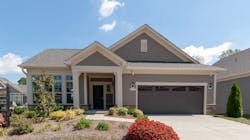Epcon’s Paul Hanson on the Supply Chain, Franchising, and Active Adult Demand
This is a longer version of an article that appeared in the May/June 2021 issue of Pro Builder.
Epcon Communities started in 1986 building homes in central Ohio for active adults before launching a franchising business in 1995 that offers house plans and support for others building communities of single-story, two- and three-bedroom homes based on market research about what Baby Boomers want in a new home. Today, the Dublin, Ohio-based company has 68 franchise builders that have completed more than 34,000 homes in 425 communities in 30 states.
Based on its 2020 revenue, Epcon is No. 51 on Pro Builder’s 2021 Housing Giants ranking of the nation’s largest builders. Paul Hanson became president in 2018 and has doubled the number of franchisees since joining the company. He also is a member of Pro Builder’s Forty Under 40 Class of 2020.
PRO BUILDER: Is there anything about the current state of the supply chain and the pace of sales versus housing starts that keeps you up at night?
Paul Hanson: Now that we are several months into the supply chain disruptions, we’ve been able to adjust our processes to adapt, for the most part. Communication and collaboration with all of our trade partners and national brand partners have been key in doing that. They’ve suggested alternative products, advised on when to place orders, and been proactive in notifying us of surprises along the way, which has allowed us to adjust in the field.
The larger issue of late has been the fact that our sales teams, like those of many builders, are writing contracts at a rate that’s outpacing our capacity to build. This has forced us to push “pause” on sales in some projects and to rush to find new trade partners quickly.
In the short-term, though, communication is also key here. We’re focused on communicating our job-start schedules weeks in advance with our early-stage trade partners to move in line ahead of other builders and making sure our online construction schedules are reliable and transparent to ensure a steady flow of progress throughout the jobs.
PB: Has Epcon’s franchising business model or its collective purchasing power presented any challenges or advantages in the current market of robust demand with extreme supply constraints and rising prices?
PH: We and our franchise builders certainly benefit from the combined volume of our entire system. Many of these franchisees are building around 50 homes per year, so they would have a small voice in their markets if they were each on their own island.
When we combine all of our collective volume, we are able to obtain great service and preferred pricing through our national brand partners. Several have called me personally for guidance on how to navigate the supply chain disruptions through our national representatives, and it has made a substantial difference in their ability to meet build times and closings goals.
PB: Do you see more price elasticity in this economic climate among your buyers for 55-plus homes compared with other buyers or house products?
PH: One of the characteristics of this market niche is that these buyers tend to have substantial net worth and little trouble paying for the final home they want. We have seen that hold true throughout the rising prices of late 2020 and early 2021.
Many of our buyers are also able to take advantage of the HECM [Home Equity Conversion Mortgage] program [through the Federal Housing Administration], so they only pay a fraction of the price increases through an increased down payment. A macroeconomic concern I do have related to this would be with interest rates, which could have a larger impact on our buyers than price increases.
PB: Regarding trends, what do you see ahead for homebuyers’ online experience?
PH: Our industry has yet to execute on a fully online buying experience, and that is a big focus for us. We’re working with a tech startup that is transferring our building plans into their platform, and they have already shown us a few demos that allow buyers to browse our offerings, “build” their house in a visualizer, and then print out a contract summary for the visit to the sales center. We see this as the future of the industry, and it’s the type of seamless, simple, buyer-focused process we want our buyers to experience.
PB: What do you see regarding increased interest in the suburban markets and from whom?
PH: Many of our buyers want their final home to be in the same town as their last home, so we are still seeing strong demand and activity in our prime, in-town locations. However, many of them are also willing to relocate to be near their children or grandchildren, so we have noticed increased activity in what used to be considered secondary or even tertiary markets as Millennials are more often able to work from home indefinitely and are choosing lower cost-of-living areas. We expect this trend to outlast the pandemic as employees settle in with the convenience of the work-from-home lifestyle and insist on it from their employers.





